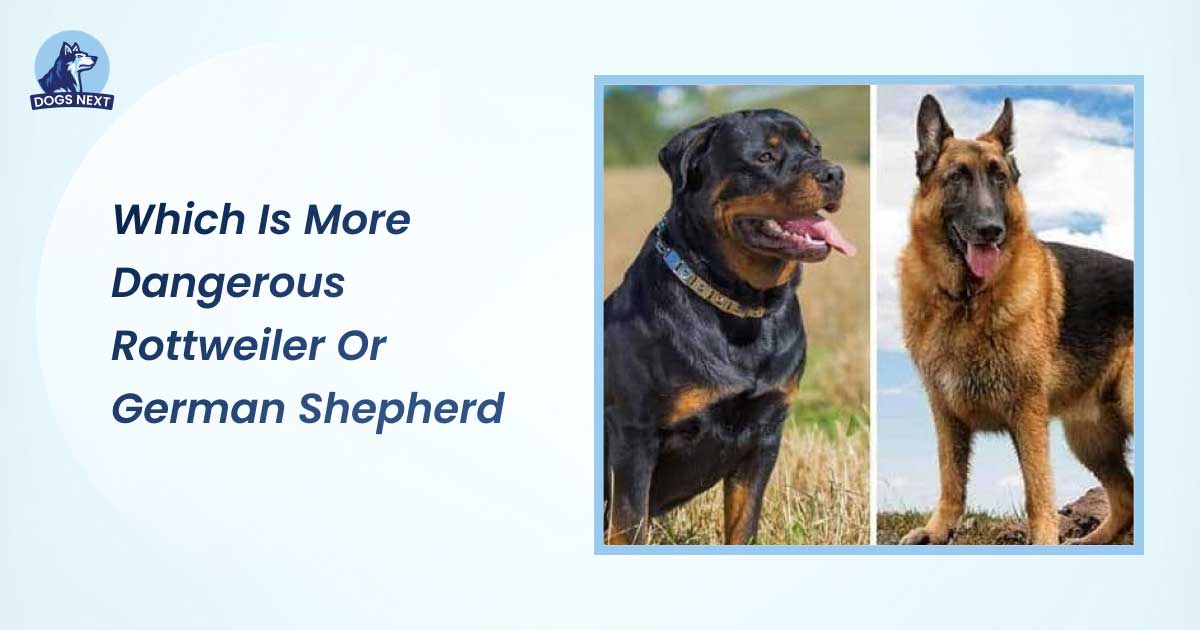Rottweilers are generally considered more dangerous than German Shepherds due to their stronger bite force and aggressive tendencies. Rottweilers and German Shepherds are both powerful breeds often compared for their strength and loyalty.
While both can be protective, Rottweilers are often perceived as more dangerous. This perception is based on their aggressive behavior and powerful bite. German Shepherds are also strong but are usually more trainable and obedient. Proper training and socialization are crucial for both breeds to ensure they behave safely.
Potential dog owners must research thoroughly and consider their ability to handle these strong, intelligent dogs. Understanding each breed’s nature helps in making an informed decision, ensuring a safe and rewarding pet ownership experience.
Temperament And Behavioral Traits Of Rottweilers
When comparing the dangers of Rottweilers and German Shepherds, understanding their temperament and behavioral traits is crucial. Rottweilers, known for their strength and loyalty, have distinct characteristics that influence their behavior. Let’s explore the temperament and behavioral traits of Rottweilers.
Rottweiler Personality Traits
Rottweilers are known for their loyalty and protectiveness. These dogs are often used in roles that require a high level of trust and dedication, such as police and military work.
Key personality traits of Rottweilers include:
- Loyalty: Rottweilers form strong bonds with their family members. They are often very affectionate and enjoy spending time with their loved ones.
- Protectiveness: These dogs are natural protectors. They are alert and will often guard their home and family.
- Independence: Rottweilers can be quite independent. This trait means they might not always seek constant attention, but they remain aware of their surroundings.
- Confidence: Rottweilers have a confident demeanor. They are self-assured and can handle various situations with composure.
Understanding Rottweiler temperament is essential for proper training and socialization. Early socialization helps in managing their protective instincts. Rottweiler training needs are specific and require consistency. Proper training can channel their natural traits positively.
How Rottweilers Display Aggression
Rottweilers can display aggression if not trained or socialized properly. Recognizing the signs of aggression is important for understanding Rottweiler behavior.
Common ways Rottweilers display aggression include:
- Growling: A low, rumbling growl can indicate discomfort or a warning to back off.
- Barking: Loud and continuous barking can be a sign of perceived threats or intruders.
- Snapping: Quick, sharp snapping can occur if the dog feels cornered or threatened.
- Staring: A hard, fixed stare is often a precursor to more aggressive actions.
Behavior of Rottweilers can be managed with proper training. It’s crucial to establish leadership and consistency in commands. Rottweiler training needs focus on positive reinforcement and socialization from an early age. This helps in reducing unwanted aggressive behaviors.
A table summarizing Rottweiler aggression signs:
| Sign of Aggression | Description |
|---|---|
| Growling | Low, rumbling sound indicating discomfort |
| Barking | Loud and continuous, signaling perceived threats |
| Snapping | Quick, sharp motions usually if cornered |
| Staring | Hard, fixed gaze indicating potential aggression |
Proper training and socialization are key to managing Rottweiler behavior. Understanding these traits helps in fostering a healthy relationship with these loyal and protective dogs.
Temperament And Behavioral Traits Of German Shepherds
When discussing which breed is more dangerous between the Rottweiler and the German Shepherd, understanding the temperament and behavioral traits of German Shepherds is crucial. These dogs are known for their intelligence, loyalty, strong protective instincts, and unique reactions to strangers. By examining these characteristics, we can better understand the German Shepherd personality traits and their behavior.
Intelligence
German Shepherds are known for their exceptional intelligence. This makes them one of the most trainable dog breeds. Their intelligence allows them to learn new commands quickly and perform complex tasks.
Some key aspects of their intelligence include:
- Quick learners: They can understand and obey commands after only a few repetitions.
- Problem-solving abilities: They can figure out solutions to challenges on their own.
- Versatility: Their intelligence allows them to excel in various roles, such as police work, search and rescue, and service animals.
To illustrate their intelligence, here is a table comparing the learning speed of German Shepherds with other breeds:
| Breed | Commands Needed to Learn New Task |
|---|---|
| German Shepherd | 5-10 |
| Beagle | 25-40 |
| Bulldog | 40-80 |
Loyalty
One of the most notable German Shepherd personality traits is their loyalty. This makes them excellent family pets and companions. Their loyalty is reflected in their behavior and interactions with their owners.
Some key points about their loyalty include:
- Strong bond with owners: They form deep connections with their families.
- Protective nature: Their loyalty often translates into a strong desire to protect their loved ones.
- Dependability: They are reliable and can be counted on to stay by their owner’s side.
German Shepherds demonstrate their loyalty through:
- Consistent companionship: Always staying close to their owners.
- Alertness: Watching over their home and family members.
- Responsive behavior: Quickly responding to commands and calls from their owners.
Strong Protective Instincts
German Shepherds possess strong protective instincts. This makes them excellent guard dogs. Their protective nature is deeply ingrained in their behavior.
Some aspects of their protective instincts include:
- Vigilance: Always alert and aware of their surroundings.
- Territorial behavior: They protect their home and family from perceived threats.
- Bravery: Willing to confront dangers to protect their loved ones.
These instincts are part of their natural tendencies and require proper training to manage effectively. Here is a table outlining their protective behaviors:
| Behavior | Description |
|---|---|
| Barking | Alerting owners to potential threats. |
| Patrolling | Regularly checking the perimeter of their home. |
| Physical Interposition | Placing themselves between their owner and a perceived threat. |
How German Shepherds React To Strangers
The behavior of German Shepherds towards strangers varies. It depends on their training and socialization. Generally, they are cautious and reserved around unfamiliar people.
Key points about their reactions include:
- Initial wariness: They may be suspicious or standoffish at first.
- Observation: They will closely watch strangers before deciding whether they pose a threat.
- Potential friendliness: With proper socialization, they can learn to accept and be friendly towards strangers.
Training needs for German Shepherds include socialization to help them react positively to new people. Here are some tips for socializing them:
- Introduce them to various people: Exposure to different individuals helps them become more comfortable.
- Positive reinforcement: Reward them for calm and friendly behavior towards strangers.
- Controlled environments: Start socialization in a controlled setting to manage their reactions.
Factors That Influence Dog Aggression
When discussing which is more dangerous, a Rottweiler or a German Shepherd, it’s essential to examine the factors that influence dog aggression. Understanding these factors helps in managing dog aggression and ensuring the safety of both the dog and the people around it. This blog post will delve into the critical aspects that contribute to a dog’s aggressive behavior.
Training
Training plays a vital role in shaping a dog’s behavior. Both Rottweilers and German Shepherds are intelligent breeds that respond well to consistent training. However, improper or lack of training can lead to aggressive behaviors.
- Consistency: Dogs need consistent training routines. Irregular training can confuse them and lead to unpredictable behavior.
- Positive Reinforcement: Rewarding good behavior encourages dogs to repeat those actions. This method is effective for both Rottweilers and German Shepherds.
- Professional Training: Sometimes, professional training is necessary. Experienced trainers know how to handle and correct aggressive tendencies.
Below is a comparison table highlighting the training needs of Rottweilers and German Shepherds:
| Factors | Rottweiler | German Shepherd |
|---|---|---|
| Training Consistency | High | High |
| Positive Reinforcement | Very Effective | Very Effective |
| Professional Training | Often Needed | Often Needed |
Socialization
Socialization is crucial for dogs to learn how to interact with other animals and humans. Lack of socialization can lead to fear and aggression.
Here are some key points to consider:
- Early Exposure: Puppies should be exposed to various environments, sounds, and people. Early exposure reduces the likelihood of developing aggressive tendencies.
- Interaction with Other Dogs: Dogs need to interact with other dogs to learn social cues. This interaction helps them understand boundaries and reduces aggressive behavior.
- Regular Social Activities: Regular walks, playdates, and visits to dog parks help in maintaining socialization skills.
Rottweilers and German Shepherds benefit significantly from proper socialization:
| Socialization Activities | Rottweiler | German Shepherd |
|---|---|---|
| Early Exposure | Very Important | Very Important |
| Interaction with Other Dogs | Crucial | Crucial |
| Regular Social Activities | Highly Beneficial | Highly Beneficial |
Environment
The environment a dog grows up in greatly affects its behavior. Stressful or unstable environments can contribute to aggressive tendencies.
Consider these environmental factors:
- Living Conditions: Dogs need a stable and secure home. Unstable living conditions can cause anxiety and aggression.
- Daily Routine: Dogs thrive on routine. A predictable daily schedule helps them feel secure and reduces stress.
- Owner’s Behavior: Dogs often mirror their owner’s behavior. Calm and confident owners tend to have well-behaved dogs.
Comparing the environmental needs of Rottweilers and German Shepherds:
| Environmental Factors | Rottweiler | German Shepherd |
|---|---|---|
| Stable Home | Essential | Essential |
| Routine | Very Important | Very Important |
| Owner’s Behavior | Highly Influential | Highly Influential |
How Breed-specific Traits Influence Behaviors
Breed-specific traits can significantly influence a dog’s behavior. Rottweilers and German Shepherds have distinct characteristics that affect their aggression levels.
Rottweilers:
- Protective Nature: Rottweilers are naturally protective of their family and territory. This trait can lead to aggression if not properly managed.
- Strong-Willed: They have a strong will and need a firm owner. Without proper guidance, they can become dominant and aggressive.
German Shepherds:
- Intelligent and Eager to Please: German Shepherds are highly intelligent and eager to please their owners. This trait makes them more trainable but can also lead to anxiety if not stimulated.
- Loyalty: Their loyalty can sometimes translate into over-protectiveness, leading to aggressive behavior towards strangers.
Summary of breed-specific traits:
| Trait | Rottweiler | German Shepherd |
|---|---|---|
| Protective Nature | High | Medium |
| Strong-Willed | Very High | Medium |
| Intelligence | High | Very High |
| Loyalty | High | Very High |
Safety Tips For Rottweilers And German Shepherds
Rottweilers and German Shepherds are both strong and protective breeds. Many people wonder which is more dangerous. The truth is, both can be safe with the right care. Here are some safety tips for Rottweilers and German Shepherds to ensure they are well-behaved and happy.
Importance Of Early Training, Socialization, And Regular Exercise
Early training is crucial for both Rottweilers and German Shepherds. Puppies should start training at a young age to learn basic commands. This helps them grow into obedient adults.
Socialization is another key aspect. Exposing your dog to different environments, people, and other animals helps them become more adaptable. This reduces the chances of aggressive behavior.
- Introduce your puppy to various sounds and sights.
- Arrange playdates with other dogs.
- Take them to dog parks.
Regular exercise is essential for these active breeds. It keeps them physically fit and mentally stimulated.
| Activity | Frequency |
|---|---|
| Daily Walks | 1-2 times per day |
| Play Sessions | 30 minutes daily |
| Training Exercises | 15 minutes daily |
Tips On Setting Boundaries
Setting boundaries is important in managing protective dog breeds like Rottweilers and German Shepherds. Clear rules help your dog understand what is acceptable behavior.
Use consistent commands and ensure everyone in the household follows the same rules. This avoids confusion and reinforces good behavior.
Establish routines for feeding, walking, and sleeping. Predictable schedules help dogs feel secure.
- Set specific areas for eating and sleeping.
- Use gates to limit access to certain rooms.
- Train your dog to wait before entering or exiting the house.
Positive reinforcement is effective. Reward your dog for obeying rules with treats or praise. Avoid harsh punishments as they can lead to fear and aggression.
Creating A Positive Environment
Creating a positive environment ensures your dog feels loved and secure. This is vital for responsible dog ownership.
Provide a comfortable space for your dog to rest. A cozy bed in a quiet corner is ideal.
Engage in bonding activities like playing fetch or going for hikes. This strengthens your relationship and keeps your dog happy.
- Offer puzzle toys to stimulate their mind.
- Rotate toys to keep them interested.
- Schedule regular vet check-ups to ensure good health.
Avoid stressful situations. Loud noises and chaotic environments can make your dog anxious. Keep their living space calm and serene.
Following these dog safety tips helps in managing protective dog breeds effectively. It ensures a harmonious and safe environment for both your dog and your family.
Frequently Asked Questions
Which Breed Is More Aggressive?
Both Rottweilers and German Shepherds can be aggressive if not trained properly. Proper socialization is key. Rottweilers tend to be more protective, while German Shepherds are often more obedient and trainable.
Are Rottweilers More Dangerous Than German Shepherds?
Rottweilers can be more dangerous due to their strength and protective nature. However, with proper training, both breeds can be safe and loyal pets.
Which Breed Is Better For Families?
German Shepherds are often better for families due to their trainability and loyalty. Rottweilers can also be good family pets with proper training and socialization.
How Do Training Needs Differ?
German Shepherds require consistent training and mental stimulation. Rottweilers need firm, consistent training and early socialization to manage their protective instincts.
Conclusion
Choosing between a Rottweiler and a German Shepherd depends on various factors. Both breeds have their unique traits and potential dangers. Proper training and socialization are crucial. Ultimately, the dog’s temperament and your ability to manage it matter most. Always consider your lifestyle and experience with dogs before making a decision.

I’m David, an expert contributor and writer, with two furry friends of my own, I know the challenges of raising and caring for dogs. From training to nutrition and health, my goal is to provide valuable insights and advice to help create strong bonds and happy, healthy lives. Find me in Twitter.




